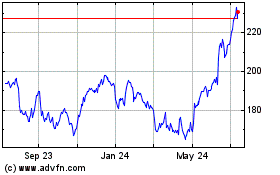Samsung Expects Earnings Rebound Powered by Chips
October 07 2015 - 8:50AM
Dow Jones News
SEOUL—Samsung Electronics Co.'s surprisingly upbeat
third-quarter guidance highlights how its components arm has become
a key driver of earnings growth, but even that business faces
headwinds as the global supply of chips appears set to outpace
demand.
Research firm Gartner earlier this year cut its growth
projection for global chip sales to 2.2% from 4%, citing a weaker
outlook for major applications that drive the semiconductor market,
including smartphones, and tablets.
For computer memory chips known as DRAM, of which Samsung is the
No. 1 supplier, the research firm expects global revenue growth to
slow to 3.8% this year, following a 32% rise in 2014.
Next year, DRAM revenue will likely decline 17% because of
potential oversupply in the market. Both Samsung and rival SK Hynix
Inc. plan to build new chip plants over the next several years.
"The strong momentum in the chip business will wane," said C.W.
Chung, an analyst with Nomura in Seoul. "The mobile unit isn't out
of the woods yet and unless that changes, it won't be easy for
Samsung to get back on an overall growth track."
Samsung said it expects third-quarter operating profit to jump
80% for the three months ended Sept. 30 to about 7.3 trillion
Korean won ($6.3 billion), its first year-over-year profit rise
since the third quarter of 2013 when the company posted a 26%
increase. The company said revenue likely rose 7.5% to 51 trillion
won.
The company benefited from a stronger U.S. currency as it gets
paid for components mostly in U.S. dollars. Samsung makes more in
value terms when sales of chips and screens are translated back
into Korean won. The U.S. dollar rose 12% against the Korean won
from a year earlier at the end of September.
Samsung's mobile division, which had powered the company's
earnings growth for much of 2012 and 2013, likely performed better
in the third quarter. The company streamlined its smartphone lineup
to cut costs, while it introduced its flagship models faster to
combat stiff competition. But as growth in global demand for
smartphones cools amid saturated markets, analysts say the mobile
unit's quarterly profit will likely come in at less than 2.5
trillion won, which is about half the level seen during its peak
years. Samsung didn't provide third-quarter guidance for its mobile
unit.
Samsung launched a pair of new smartphone models --the Galaxy
Note 5 and the Galaxy S6 Edge + -- in August, advancing the timing
of their launch by several weeks to beat Apple Inc. to the market.
The next flagship Galaxy S smartphone model is also expected to be
released earlier than usual, as Samsung struggles to hold on to its
market share.
In the second quarter, Samsung shipped 74.1 million smartphones
globally, maintaining its top market share of 20%, according to
data tracker Counterpoint Research. But it was the only company
among the top five vendors whose market share slipped compared with
the year-earlier period. Samsung had accounted for an estimated
24.2% share of the global smartphone market a year earlier.
Margins on the sale of mobile phones likely will stay under
pressure as Samsung has been launching discounts and promotions to
lure consumers. Analysts expect profit margin from the mobile
business to be 8% to 9%, compared with about 30% for its chip
business.
In the U.S., new Samsung phones are sold with a rebate of as
much as $120 through select carriers, with an extra benefit for
customers switching from iPhones. SK Telecom, South Korea's largest
carrier, on Wednesday, announced price cuts on some of Samsung's
main smartphone models, including the Galaxy S6. Analysts say price
cuts are inevitable for Samsung given stiff competition.
Samsung "will have to release a model that other makers can't
make," said Yoo Jong-woo, an analyst with Korea Investment &
Securities in Seoul. "High-end phones featuring flexible
displays—like the ones that are foldable—will be the only way
Samsung could seek an increase in its market share in the premium
market."
Samsung's shares got a boost Wednesday following its upbeat
guidance and expectations for a stock buyback later this year.
A spokesman for Samsung declined to comment on a potential stock
buyback. In November last year, Samsung disclosed plans to
repurchase $2 billion worth of shares to boost shareholder returns,
its first such move in seven years. Samsung's shares are still down
about 6% year-to-date.
Write to Min-Jeong Lee at min-jeong.lee@wsj.com
Access Investor Kit for "Apple, Inc."
Visit
http://www.companyspotlight.com/partner?cp_code=P479&isin=US0378331005
Subscribe to WSJ: http://online.wsj.com?mod=djnwires
(END) Dow Jones Newswires
October 07, 2015 08:35 ET (12:35 GMT)
Copyright (c) 2015 Dow Jones & Company, Inc.
Apple (NASDAQ:AAPL)
Historical Stock Chart
From Mar 2024 to Apr 2024

Apple (NASDAQ:AAPL)
Historical Stock Chart
From Apr 2023 to Apr 2024
